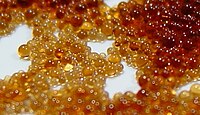
Photo from wikipedia
Abstract A novel polystyrene-poly(hydroxamic acid) interpenetrating network resin (PS-PHA IPNs) was successfully synthesized by suspension polymerization and interpenetrating network technology. The effects of various experimental parameters, including pH, contact time… Click to show full abstract
Abstract A novel polystyrene-poly(hydroxamic acid) interpenetrating network resin (PS-PHA IPNs) was successfully synthesized by suspension polymerization and interpenetrating network technology. The effects of various experimental parameters, including pH, contact time and initial concentrations of rare earth ions on the adsorption capacity were discussed in detail. Under the condition of pH 4.0 (La3+), 1.0 (Ce3+) and 3.0 (Y3+), respectively, PS-PHA IPNs can reach equilibrium adsorption in 6 hours and get maximum adsorption capacities (1.08, 1.43 and 1.36 mmol/g). The adsorption process of PS-PHA IPNs for La(III), Ce(III) and Y(III) ions can be described by liquid membrane diffusion, particle diffusion and chemical reaction. The adsorption process is a spontaneous and endothermic process and can be better simulated by Langmuir adsorption isotherm. The studies of SEM-EDS indicate that rare earth ions are adsorbed on the surface of PS-PHA IPNs. FTIR and XPS analysis further prove that rare earth ions are chemisorbed on the surface of PS-PHA IPNs. These results reveal that the as-prepared PS-PHA IPNs is a promising adsorbent for adsorption of rare earth ions due to their higher adsorption capacity than other adsorbents.
Journal Title: Journal of Rare Earths
Year Published: 2020
Link to full text (if available)
Share on Social Media: Sign Up to like & get
recommendations!